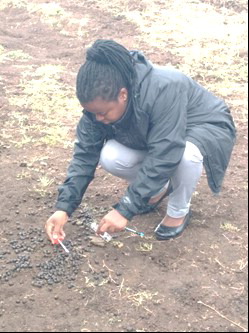|
Cycle 4 (2015 Deadline)
DNA barcoding to combat wildlife crime
PI: Henry Ndithia (ozwara@primateresearch.org), National Museums of Kenya
U.S. Partner: David Schindel, Smithsonian Institution
Project Dates: October 2015 - December 2019
Project Overview
Wildlife criminals, poachers, and traffickers of endangered species protected under CITES and national laws are developing new ways to avoid detection and prosecution. In the case of protected animals, traffickers are shipping them as butchered and processed meat, eggs or juvenile stages, dried powders, and other forms that have proven difficult to identify. In these forms, even taxonomic experts cannot provide species identifications based on morphology because diagnostic characteristics (commonly provided by bones and hides) are absent from confiscated material. As a result, border inspectors, police, and park rangers may not suspect that intercepted objects come from protected species. Even in cases where suspicions are aroused and the materials are confiscated, crime investigators aren’t able to identify them with confidence. The same may prove true even for the expert zoologists who receive the objects for identification. In those rare cases when an expert provides an identification using the few morphological features preserved, it is difficult to overcome the objections of defense attorneys who raise doubts in the minds of magistrates.
This project proposes to use “DNA barcode” sequence data to identify confiscated materials by their species of origin. DNA barcoding has become an accepted and commonly used method for species identification practiced by taxonomists, ecologists and other academic researchers. Since 2012, Kenya has been one of six partner countries in the Google-supported Barcode of Wildlife Project (BWP), which has provided training to staff at the National Museums of Kenya and the Kenya Wildlife Service. These institutions are assembling a reference library of DNA barcodes from endangered species that can be used to identify confiscated material. The Kenyan researchers continue to receive technical support and advanced training from the Smithsonian Institution in Washington, the U.S. Government-supported partner on this project.
The two main objectives of the project are to expand training and technical assistance to new participants in Tanzania, as well as strengthen Kenya’s systemic response to poaching in two ways. First, DNA-based research on endangered species through the National Museums of Kenya will create new tools for prosecuting wildlife criminals. Second, collaboration with the Kenya Wildlife Service will put these tools to work in Kenyan courtrooms. The result should be a rapid near-term rise in the rate of convictions for poaching and trafficking, followed by long-term growth in the population sizes of endangered species and measures of ecosystem health. These should translate into prosperity in agriculture, greater food security, job creation, and a strong and sustainable tourism industry.
Final Summary of Project Activities
 | | Animal Sample Collection. Photo courtesy of Dr. Ndithia | Building on the predecessor project, the PEER project team identified gaps in wildlife species that are poached, illegally-traded or are trafficked, from the initial 200 species identified by the Barcode of Wildlife Project Kenya (BWPK). The team visited different parts of Kenya and collected tissue samples (either voucher or e-voucher depending on whether an animal species is allowed to be collected in the wild) from five individuals of each species where possible. A total of 225 samples were worked on (Mammals 49 (17), Birds 76 (26), Fish and Marine Samples 59 (17), Herpetofauna 40 (14) (individuals and species in brackets)). This information was entered in a database called the Field Information Management System (FIMS). Voucher specimens were later catalogued and stored in the collection for reference. In the laboratory, the tissues were entered into the Laboratory Information Management System (LIMS) database. Thereafter, tissues samples were analyzed in the lab by going through the process of DNA extraction, DNA amplification, DNA sequencing and purification and eventual publication in GenBank. In total, 161 barcodes were uploaded in GenBank. 290 tissues that had been collected were sub-sampled into barcoded tubes for archival storage. DNA was then extracted and sub-sampled into barcoded tubes as well for archival storage. 260 genomic DNA samples were amplified targeting the Cytochrome c oxidase subunit 1 gene. 201 amplicons have been purified and submitted for sequencing. The data was transferred from the Amazon servers to the National Museums of Kenya (NMK) servers. The team now accesses the database locally and is validating the field metadata on the Biscicol website (http://www.biscicol.org/). Additionally, the capacity of the molecular genetics lab was improved through renovation that provided the lab with a facelift from the deteriorating state it was in, replacing obsolete equipment with state of the art equipment. This center will not only serve Kenya but the region. In addition, the project built the capacity in Tanzania by initiating the DNA barcode process there through the training of 12 new participants on DNA barcoding. The project also trained one PhD student in Kenya, who is studying interspecific hybridization in lovebirds.
Dr. Ndithia's future plans include raising funds that can finalize the process of initiating DNA barcode in Tanzania and establish a DNA library in Tanzania. The process in Tanzania faced numerous challenges that made it difficult to have the trained participant to sit for the proficiency test that qualifies one to be a DNA analyst. Additionally, besides the need to develop a DNA library in Tanzania, there is need to establish a Museums collection for voucher specimen in Tanzania, and to conduct training on standard operating procedures (SOPs) a step that is important in the DNA library construction process.
Back to PEER Cycle 4 Grant Recipients
| 



